Welcome to Sikkim - General Information
Sikkim has been given many names. The Lepchas, original inhabitants of the land called it Nye-mae-el `paradise'. The Limbus named it Su Khim or `new house' while to the Bhutias it was Beymul Demazong `the hidden valley of rice'. Today, travelers embarking on a journey of Sikkim discover a mystical wonderland of spectacular natural beauty. The panoramic perfection of the snow-capped Himalayas, the heady scent of flower-bedecked meadows, the vibrant culture and joyous festivals, the infinite variety of its flora and fauna makes it a holiday that is at once fascinating and challenging. The crowning glory of Sikkim is Mt. Khangchendzonga, the third highest mountain in the world. With magnificent snow and ice scenery it is often regarded as the undisputed monarch among the peaks of the world. But for the Sikkimese Khangchendzonga is much more than a mountain and is revered as the abode of their guardian deity Dzo-nga.
Even today the mountain god is invoked and prayed to during Pang Lhabsol, a major Sikkimese festival, which also commemorates the blood brotherhood sworn between the Lepchas and the Bhutias at Kabi in the fifteenth century. The sacred mountain can be viewed from every corner of Sikkim and remains an intrinsic part of the consciousness of the people. Sikkim shares its border with Nepal in the west and Bhutan in the east, with the Tibetan plateau rising from its northern border. It was once a Himalayan monarchy and part of the fabled Silk Route to China. Its merger with India in 1975 has offered a window to the world to discover the treasures of this hidden land. Sikkim's tiny size geographically belies the profound diversity she offers. The state has the steepest rise in altitude over the shortest distance and has within its 7,096 sq. kms the entire climatic range, from tropical to temperate to alpine, bestowing on the land an intense natural heritage. Lush and thick forests, flush with blooms of exotic flora, hilly expanses embellished by Sikkim's two main rivers, the Teesta and the Rangeet, the picturesque villages, hot springs and waterfalls have a compelling appeal. The mountain sides are dotted with many caves which are considered holy by the people and revered as places of pilgrimage. The 135 feet tall statue of Guru Padmasambhava is situated at Samdruptse, South Sikkim.
Sikkim has much to offer all her visitors. From popular home stays where one can get a firsthand experience of rural Sikkim to endless possibilities for adventure sports. From ancient monasteries and flamboyant festivals to all the amenities of the modern world. The State is naturally gifted having all sorts of destinations and circuits required for the tourists. Tourism in Sikkim has impressive varieties of Tourism Products, some of them are :
* Organic, Green and Pollution Free State
* Very rich Culture, traditions, heritage and strong commitment
* Eco-tourism & Wildlife
* Village Tourism
* Adventure Tourism
* Wellness, Health, Yoga, Herbal and medical tourism
* Religious, culture, Heritage and pilgrimage Tourism
* Conference Tourism and many more
The mighty and majestic mountains, green valleys, wilderness & sense of adventure, delightful cuisines, peaceful and crime free State, Hot spot of biodiversity and a mixture of things that would make any place on the earth a delight to visit, has made Sikkim the hot destination for Tourism that it should be. Virtually unexplored, offers unique opportunities in almost all the major aspects of Tourism.
About Gangtok :
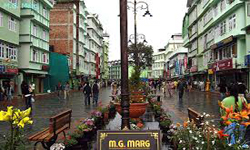 The capital and the largest town of North East Indian state Sikkim is located at an altitude of 5,800 feet in the eastern Himalaya sharing its borders with Nepal and Bhutan is famous for its spectacular view of Khangchendzonga and the perfect base for travel through the state. In early 20th century, Gangtok became a major stopover on the trade route between Lasha in Tibet and cities such as Calcutta in British India. After India won its independence from Britain in 1947, Sikkim chose to remain an independent monarchy, with Gangtok as its capital. In 1975, after the integration with the union of India, Gangtok was made India's twenty-second state capital.
Gangtok is a cosmopolitan town which offers all possible amenities for tourists. Hotels are available in all range of prices along with a variety of eateries serving cuisine for all tastes. MG Marg, the main street of Gangtok town is a great place to chill out and lined with shopping complexes, cyber cafes, night clubs and pool parlours becomes an added pleasure.
The capital and the largest town of North East Indian state Sikkim is located at an altitude of 5,800 feet in the eastern Himalaya sharing its borders with Nepal and Bhutan is famous for its spectacular view of Khangchendzonga and the perfect base for travel through the state. In early 20th century, Gangtok became a major stopover on the trade route between Lasha in Tibet and cities such as Calcutta in British India. After India won its independence from Britain in 1947, Sikkim chose to remain an independent monarchy, with Gangtok as its capital. In 1975, after the integration with the union of India, Gangtok was made India's twenty-second state capital.
Gangtok is a cosmopolitan town which offers all possible amenities for tourists. Hotels are available in all range of prices along with a variety of eateries serving cuisine for all tastes. MG Marg, the main street of Gangtok town is a great place to chill out and lined with shopping complexes, cyber cafes, night clubs and pool parlours becomes an added pleasure.
About Tsomgo Lake :
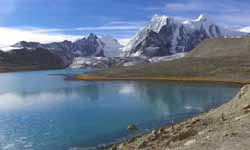 is 32 km away from Gangtok is situated at an altitude of 12400 ft is one of the highest altitudes Himalayan Lake. This oval shape lake is almost 1 km long with average depth of 50 ft is situated in east Sikkim Himalaya. Nathula Pass is another 20 km. drive from Tsomgo Lake, situated at an altitude of 14000 ft is a trade route between India and China.
is 32 km away from Gangtok is situated at an altitude of 12400 ft is one of the highest altitudes Himalayan Lake. This oval shape lake is almost 1 km long with average depth of 50 ft is situated in east Sikkim Himalaya. Nathula Pass is another 20 km. drive from Tsomgo Lake, situated at an altitude of 14000 ft is a trade route between India and China.
About Pelling :
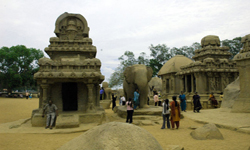 in West Sikkim is nestled at an altitude of 2,150 m (7,200 feet) is popular for its spectacular view of mighty Himalayas and the Kanchenjanga range .Places to visit in and around Pelling include the local monastery, the rock garden and waterfall at nearby Rimbi, the imposing double-pronged Kanchenjungha Falls, the archaic quaint Singshore Bridge, the Chhange Waterfalls, the Khechuperi Lake holy to Buddhists and ancient Pemyangtse monastery.
in West Sikkim is nestled at an altitude of 2,150 m (7,200 feet) is popular for its spectacular view of mighty Himalayas and the Kanchenjanga range .Places to visit in and around Pelling include the local monastery, the rock garden and waterfall at nearby Rimbi, the imposing double-pronged Kanchenjungha Falls, the archaic quaint Singshore Bridge, the Chhange Waterfalls, the Khechuperi Lake holy to Buddhists and ancient Pemyangtse monastery.
About Yumthang :
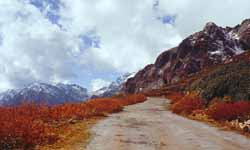 Yumthang Valley is a grazing pasture surrounded by the Himalayan mountains in the North Sikkim district of India located at an elevation of 14,000 ft at a distance of 150 km from the state capital Gangtok. It is also home to the Shingba Rhododendron Sanctuary, and has over twenty-four species of Rhododendron. A tributary of the river Teesta flows past the valley and the town of Lachung, the nearest inhabited. There is a hot spring and just 24 kms away Katao offers a panoramic view of snow capped peaks.
Yumthang Valley is a grazing pasture surrounded by the Himalayan mountains in the North Sikkim district of India located at an elevation of 14,000 ft at a distance of 150 km from the state capital Gangtok. It is also home to the Shingba Rhododendron Sanctuary, and has over twenty-four species of Rhododendron. A tributary of the river Teesta flows past the valley and the town of Lachung, the nearest inhabited. There is a hot spring and just 24 kms away Katao offers a panoramic view of snow capped peaks.
About Chungthang :
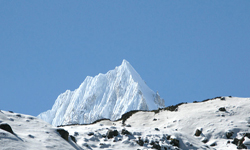 Chungthang is situated on the confluence of Lachen and Lachung Chu, 95 kms from Gangtok, and it is the starting point of the river Tista. It emerged as a major sub divisional town of North Sikkim. The place has immense potential of biodiversity with a wide variety of orchids. Plants and wild life. Just 23kms and 29 kms away from Chungthang there another two important valleys Lachung and Lachen.
Chungthang is situated on the confluence of Lachen and Lachung Chu, 95 kms from Gangtok, and it is the starting point of the river Tista. It emerged as a major sub divisional town of North Sikkim. The place has immense potential of biodiversity with a wide variety of orchids. Plants and wild life. Just 23kms and 29 kms away from Chungthang there another two important valleys Lachung and Lachen.
Gurudongmar Lake :
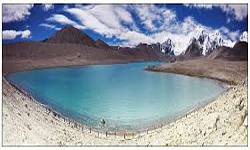 Gurudongmar Lake, 190 km from Gangtok is one of the highest lakes in the world, at an elevation of 17,100 ft . It lies in the province of North Sikkim, India, only 5 kilometres south of Chinese border. This fresh-water lake located northeast of the Kangchenjunga range in a high plateau area connected with the Tibetan Plateau. It also provides one of the source streams of the Teesta River.
Gurudongmar Lake, 190 km from Gangtok is one of the highest lakes in the world, at an elevation of 17,100 ft . It lies in the province of North Sikkim, India, only 5 kilometres south of Chinese border. This fresh-water lake located northeast of the Kangchenjunga range in a high plateau area connected with the Tibetan Plateau. It also provides one of the source streams of the Teesta River.
Ravangla :
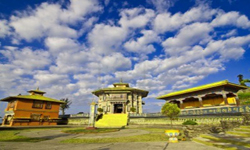 Ravangla, a small tourist town situated at an elevation of 7000 ft in South Sikkim is the transit point for Menam Hills and Borong. Mt. Kanchenjunga, Mt. Pandim, Mt. Sinialchu, Mt. Kabru are just a few of the major peaks that are clearly visible from Ravangla.
Ravangla, a small tourist town situated at an elevation of 7000 ft in South Sikkim is the transit point for Menam Hills and Borong. Mt. Kanchenjunga, Mt. Pandim, Mt. Sinialchu, Mt. Kabru are just a few of the major peaks that are clearly visible from Ravangla.
Namchi :
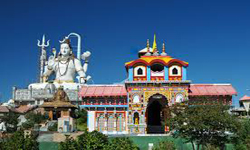 Namchi, situated at an altitude of 5500 feet above sea level is situated at a distance of 92 km from the state capital Gangtok and 90 km from the town of Siliguri. It lies off the road between Melli and Jorethang. Namchi commands panoramic view of the snow capped mountains and vast stretches of valley. It is also headquarters of South district. The area is fast growing into a tourist destination with its enormous potential for all round tourist activities. Namchi is famous for the flower festival which usually held in the month of February.
Namchi, situated at an altitude of 5500 feet above sea level is situated at a distance of 92 km from the state capital Gangtok and 90 km from the town of Siliguri. It lies off the road between Melli and Jorethang. Namchi commands panoramic view of the snow capped mountains and vast stretches of valley. It is also headquarters of South district. The area is fast growing into a tourist destination with its enormous potential for all round tourist activities. Namchi is famous for the flower festival which usually held in the month of February.
Temi Tea Garden :
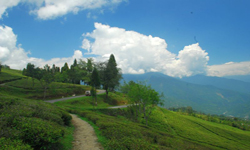 Temi Tea Garden, in Ravangla, established in 1969 by the Government of Sikkim is the only tea garden in Sikkim and considered one of the best in India and in the world. Top quality tea produces in the garden is also very popular in international market. The garden is spread over a gental slope of hills from Tendong and offers an extra ordinary view of surrounding villages
Temi Tea Garden, in Ravangla, established in 1969 by the Government of Sikkim is the only tea garden in Sikkim and considered one of the best in India and in the world. Top quality tea produces in the garden is also very popular in international market. The garden is spread over a gental slope of hills from Tendong and offers an extra ordinary view of surrounding villages






